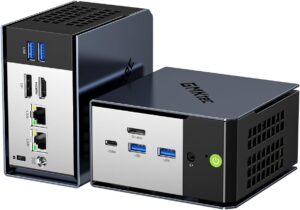What is the GMKTec EVO-X1 Mini PC?
The mini PC market has evolved dramatically, and the GMKtec EVO-X1 Mini PC represents a significant leap forward with AMD’s latest Ryzen AI 9 HX 370 processor. This compact powerhouse brings desktop-class performance, AI capabilities, and impressive gaming potential to a form factor smaller than a lunch box. In this comprehensive review, I’ll explore how this mini PC stacks up against competitors, whether it’s worth your investment, and who would benefit most from its unique combination of power and portability.
Though not palm-sized, the GMKtec EVO-X1 Mini PC measures 7.32″ x 7.32″ x 5.28″ inches and weighs 3.87 pounds, making it a compact and portable computing solution.
Key Takeaways About the GMKtec EVO-X1 Mini PC
- Cutting-edge performance: Powered by AMD’s Ryzen AI 9 HX 370 with Zen 5 architecture, delivering 12 cores, 24 threads, and up to 5.1GHz clock speeds in a mini PC form factor.
- Impressive graphics: The integrated Radeon 890M iGPU offers up to 57% better gaming performance than previous generation solutions, making casual and esports gaming feasible.
- Powerful AI capabilities: XDNA 2 architecture provides up to 50 TOPS of AI processing power, positioning the EVO-X1 for next-generation AI applications.
- Expandability through OcuLink: The OcuLink port supports external GPU connections at PCIe x4 speeds, offering a path to desktop-class graphics performance when needed.
- Exceptional memory performance: Quad-channel LPDDR5X at 8000MT/s delivers up to 76% better performance in specific workloads compared to standard DDR5.
- Comprehensive connectivity: Triple 8K display support, dual 2.5Gbps LAN, WiFi 6, and USB4 cover virtually every connectivity need for home or professional use.
- Effective thermal management: Dual cooling fans with 360-degree airflow and three performance modes balance cooling efficiency with noise levels.
- High-speed storage: Support for dual PCIe 4.0 M.2 SSDs with up to 8TB total capacity ensures fast boot times and responsive application performance.
- EVOLUTION AMD RYZEN 9 HX-370 MINI PC - GMKtec EVO-X1 is the next evolution in AI mini PC Ryzen AI 300 series, code named Strix Point. This processor brings out the highest TOPS from an NPU out, and it...
- AI NPU with XDNA 2 ARCHITECTURE - Equipped with an advanced AI NPU featuring the XDNA 2 architecture, EVO-X1 AI mini PC delivers up to 50 TOPS (Tera Operations Per Second) of AI processing power. This...
- AMD RADEON 890M iGPU GAMING PC - The latest RDNA 3.5 (Radeon 890M) in the Ryzen AI 9 HX 370 improves performance across all of our suites, which shows AMD has done wonders to improve their integrated...
What Makes the GMKtec EVO-X1 Mini PC Special? Is It Worth the Hype?
The GMKtec EVO-X1 Mini PC stands out in the crowded mini PC market by being one of the first devices to feature AMD’s cutting-edge Ryzen AI 9 HX 370 processor based on the new Zen 5 architecture. This isn’t just another iterative update – it represents a significant technological advancement for mini PCs. The Strix Point processor delivers impressive speeds up to 5.1GHz while maintaining a reasonable 65W TDP at maximum performance.
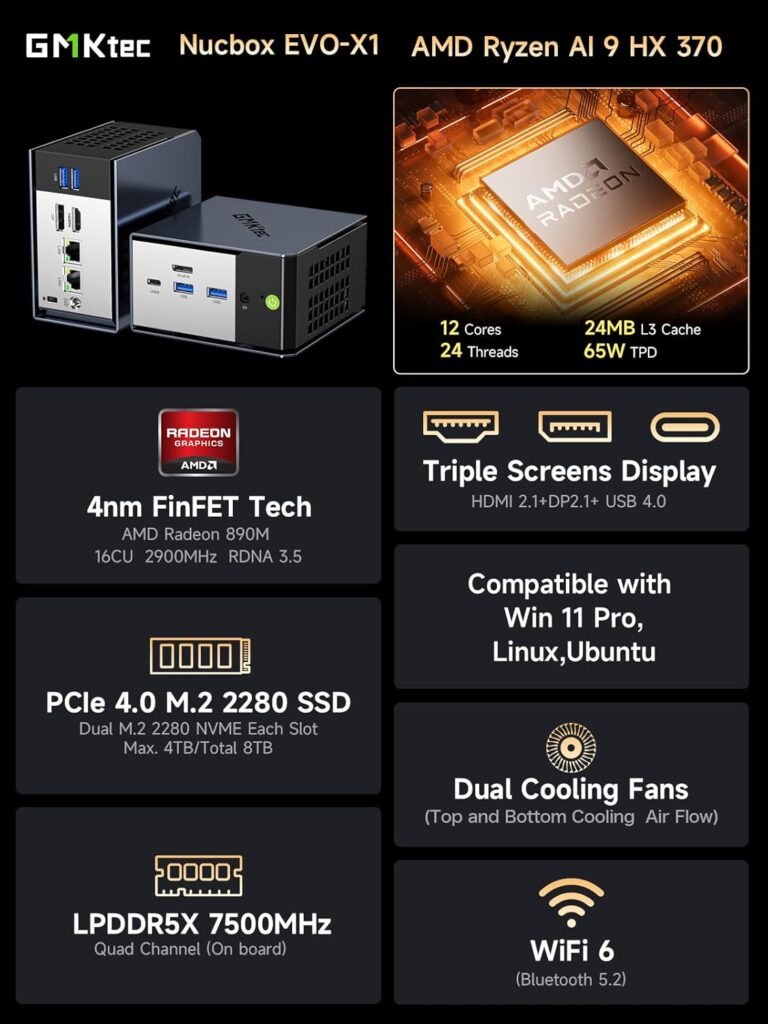
What truly distinguishes this mini PC is its AI capabilities. The integrated XDNA 2 architecture provides up to 50 TOPS (Tera Operations Per Second) of AI processing power, making it suitable for tasks like image recognition and natural language processing. This level of AI performance in such a compact form factor was unimaginable just a year ago. For professionals working with AI applications or content creators leveraging AI tools, the EVO-X1 offers capabilities previously available only in much larger, more power-hungry systems.
How Does the AMD Ryzen AI 9 HX 370 CPU Compare to Previous Generations?
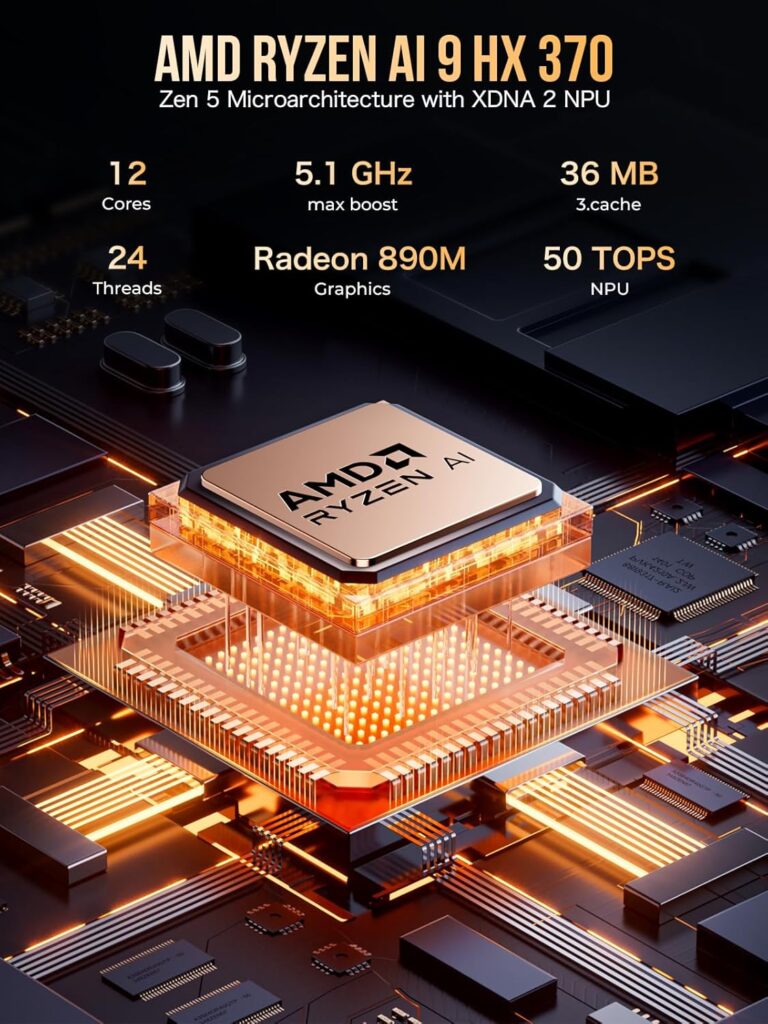
The AMD Ryzen AI 9 HX 370 represents a significant evolution in mobile processor technology now adapted for high-performance mini PCs. With 12 cores (a mix of Zen 5 cores and Zen 5c cores) and 24 threads, this CPU delivers processing power typically found in larger desktop systems. The 24MB L3 cache further enhances performance for demanding applications and multitasking scenarios.
Compared to previous generations such as the Ryzen 9 8745HS, 7940HS, or 6900HX, the new Ryzen AI 9 HX 370 provides approximately 30% better performance across various workloads. This is partly due to the improved Zen 5 architecture, which offers better IPC (Instructions Per Clock) performance and energy efficiency. For mini PC enthusiasts, this means desktop-class performance without the space requirements or power consumption of traditional desktop systems.
The CPU is particularly impressive considering its 65W peak power consumption, which balances performance with thermal efficiency – crucial for a compact system like the GMKTec EVO-X1 Mini PC. Whether you’re running CPU-intensive tasks like video editing, 3D rendering, or compiling code, the Ryzen AI 9 HX 370 provides substantial performance improvements that make this mini PC competitive even against many traditional desktops.
How Does the Radeon 890M iGPU Handle Gaming Performance?
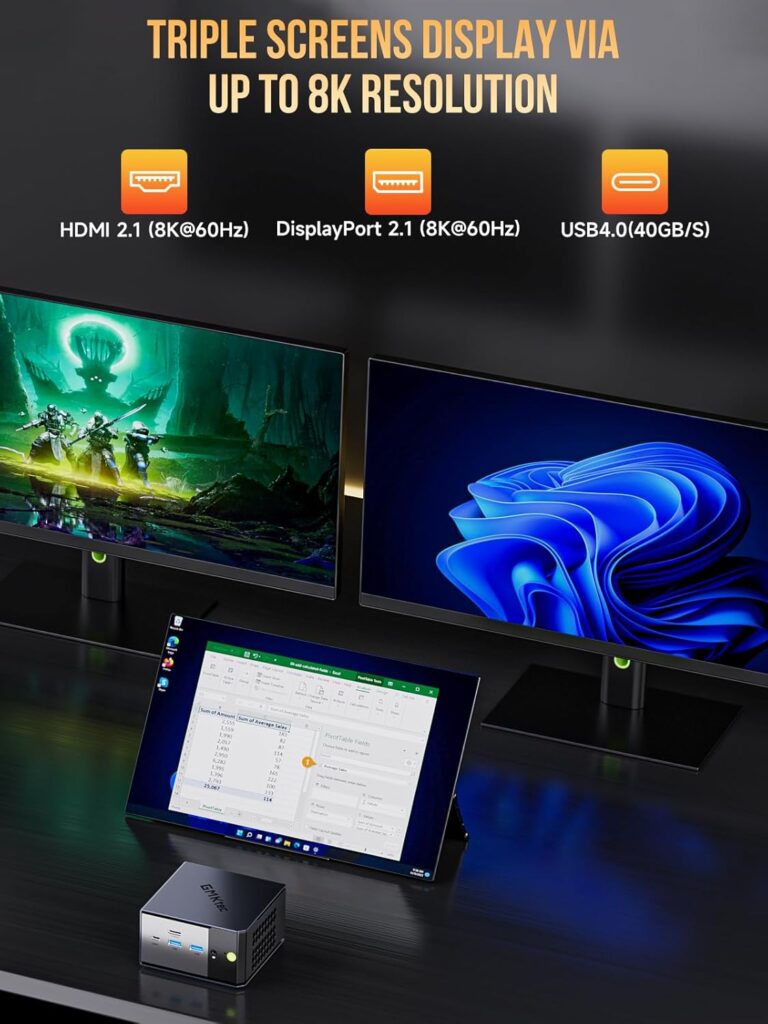
The integrated Radeon 890M GPU in the GMKTec EVO-X1 Mini PC represents AMD’s latest RDNA 3.5 graphics architecture, bringing surprising gaming capabilities to this compact form factor. GMKtec claims that the EVO-X1’s Radeon 890M outperforms the previous generation Radeon 780M by up to 57% in some games, making it significantly more capable for gaming than typical mini PCs.
This igpu handles many popular titles at 1080p with medium to high settings, achieving playable frame rates even in relatively demanding games. For esports titles like Counter-Strike or Valorant, you can expect excellent performance at high refresh rates. Even some AAA games are playable at reduced settings, though don’t expect to run the latest titles at maximum quality – that’s still the domain of systems with dedicated GPUs.
What makes the graphics performance particularly impressive is the support for technologies like AMD’s upscaling solutions, which can significantly improve frame rates with minimal visual quality loss. While not explicitly stated in the manufacturer’s description, the RDNA 3.5 architecture typically includes support for features like AMD FSR (FidelityFX Super Resolution) and frame generation technologies that can further enhance gaming performance.
Is the OcuLink Port a Game-Changer for External GPU Support?
![Close-up of the OcuLink port connection with an external GPU demonstrating high-speed data transfer]](https://minipctech.com/wp-content/uploads/2025/04/GMKtec-EVO-X1-Oculink-768x1024.jpg)
One of the most exciting features of the GMKtec EVO-X1 Mini PC is the inclusion of an OcuLink port, which could revolutionize how we think about mini PC gaming potential. This port enables connection to external GPUs (eGPUs) with significantly higher bandwidth than traditional solutions. Operating at PCIe x4 speeds compared to Thunderbolt’s x3, OcuLink provides better frame rates and lower latency for gamers and content creators using external graphics solutions.
The OcuLink port supports data transfer speeds up to 64 Gbps, enabling nearly full-speed operation of even high-end graphics cards when connected via an appropriate external enclosure. This means you could use the compact EVO-X1 for everyday computing, then connect it to an external GPU when you need serious graphics horsepower for gaming or creative work – essentially getting the best of both worlds.
For content creators and professionals working with graphics-intensive applications, this flexibility is invaluable. You can maintain the small footprint of a mini PC for most tasks, then tap into desktop-class graphics performance when needed. While external GPU solutions add cost, they provide an upgrade path that traditional mini PCs typically lack.
How Fast is the LPDDR5X RAM, and Does It Matter for Real-World Performance?
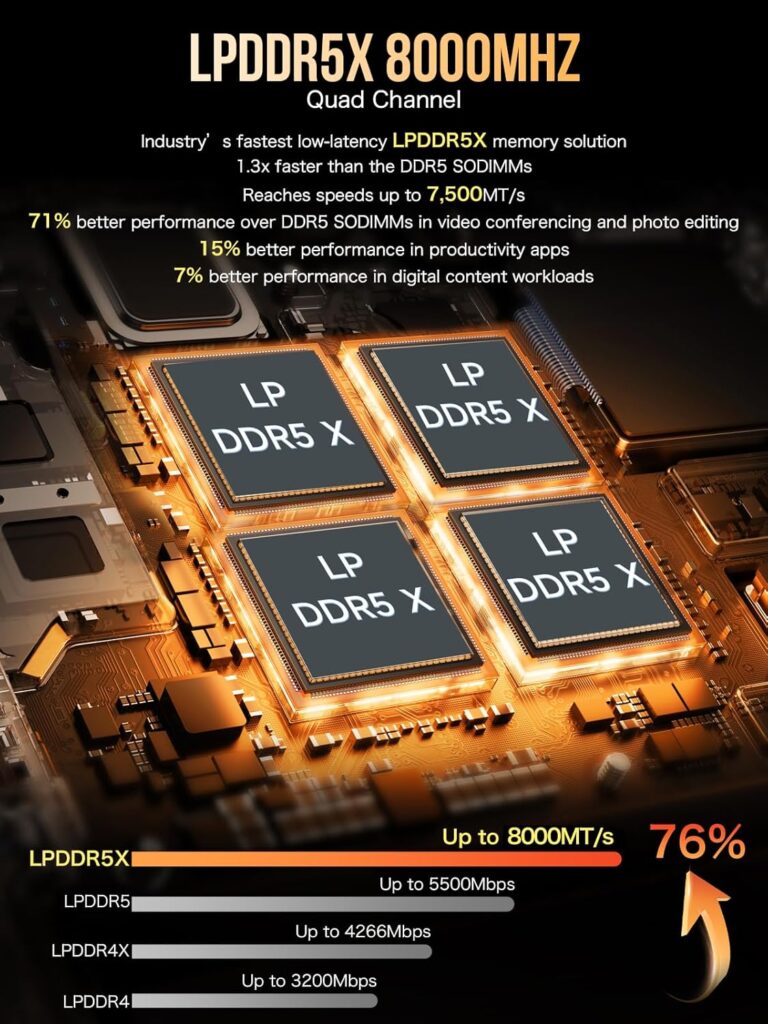
The GMKtec EVO-X1 Mini PC incorporates quad-channel LPDDR5X memory with speeds up to 8000MT/s, which represents one of the fastest memory solutions available in any compact computing device. This type of RAM is permanently installed on the motherboard rather than using traditional SODIMM slots, allowing for higher speeds and better integration with the system architecture.
According to GMKtec, this memory solution runs 1.3x faster than standard DDR5 SODIMMs and delivers 76% better performance in video conferencing and photo editing tasks. For productivity applications, the performance improvement is around 15%, while digital content workloads see a 7% boost. These numbers translate to real-world benefits, particularly for users who regularly work with memory-intensive applications.
The high memory bandwidth is especially beneficial when leveraging the integrated Radeon 890M graphics, as both the CPU and GPU share the system memory. The faster the memory, the better the graphical performance can be, particularly at higher resolutions. This symbiotic relationship between the memory subsystem and integrated graphics is part of what makes the EVO-X1 surprisingly capable as a gaming and content creation platform despite lacking a dedicated GPU.
What Connectivity Options Does the GMKTec EVO-X1 Mini PC Offer for Multiple Displays and Peripherals?
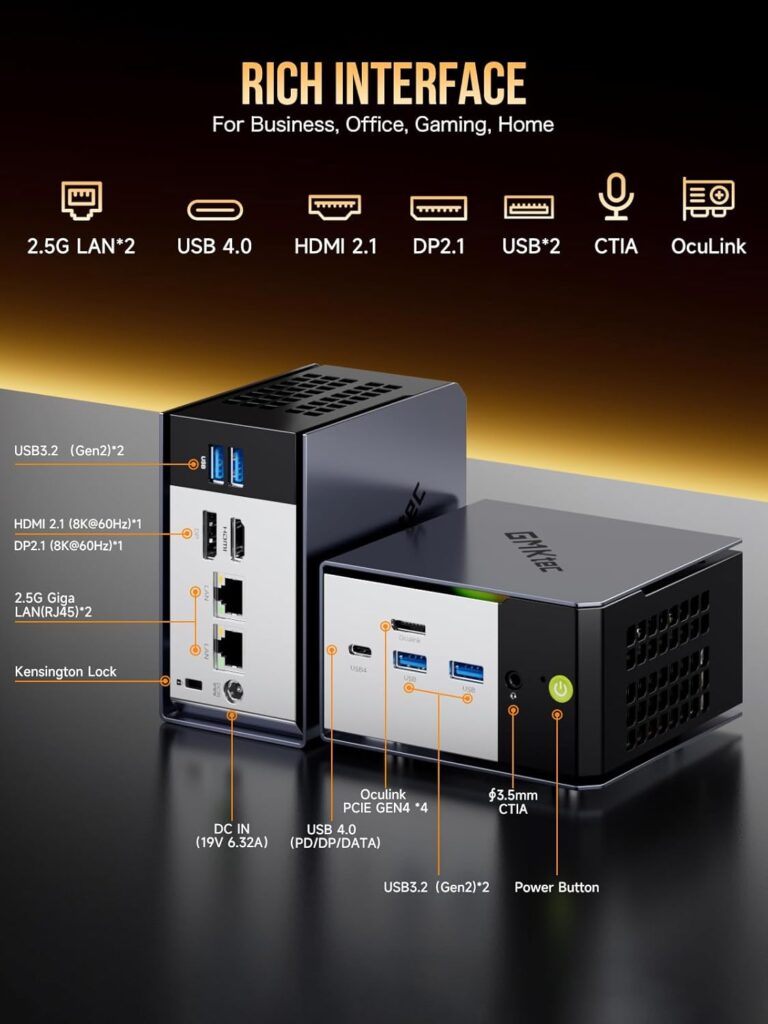
The GMKtec EVO-X1 Mini PC features an impressive array of connectivity options that rival much larger desktop systems. Most notably, it supports triple-display 8K output via HDMI 2.1 (8K@60Hz), DisplayPort 2.1 (8K@60Hz), and USB4 (40Gbps) with DisplayPort Alt Mode. This level of display support is exceptional for a mini PC and makes the EVO-X1 suitable for complex workstation setups, content creation, and immersive gaming environments.
For networking, the GMKTec EVO-X1 Mini PC offers dual Intel i226V 2.5Gbps LAN ports, providing options for advanced networking configurations like link aggregation, failover, or dedicated connections for different purposes. This dual NIC setup is particularly valuable for users who need reliable, high-speed networking for file servers, virtualization, or network-intensive applications. Wireless connectivity is equally impressive with WiFi 6 and Bluetooth 5.2 integration.
USB connectivity is comprehensive with USB4 ports supporting Power Delivery (PD), DisplayPort Alt Mode, and data transfer at up to 40Gbps. Additional USB 3.2 Type-A ports provide connectivity for peripherals, external storage, and other devices. The inclusion of a 3.5mm audio jack ensures compatibility with headphones and speakers. For security-conscious users, the Kensington lock slot allows physical securing of the device in public or shared environments.
How Does the Cooling System Handle the 65W TDP Processor in Such a Compact Design?
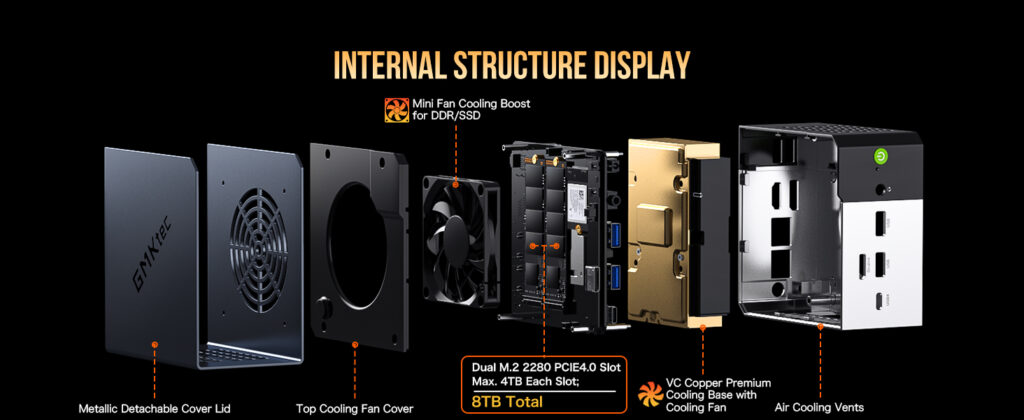
Effective cooling is perhaps the biggest challenge for high-performance mini PCs, and GMKtec has addressed this with their “Hyper Ice Chamber 2.0” cooling system. The GMKtec EVO-X1 Mini PC employs dual cooling fans with a 360-degree airflow design, featuring both top and bottom fans to maximize heat dissipation from the compact chassis. This approach allows the system to handle the 65W TDP of the Ryzen AI 9 HX 370 processor even under sustained workloads.
The copper base of the cooling system helps efficiently transfer heat away from the processor, and GMKtec claims they’ve managed to reduce fan noise to just 35dB in Quiet mode. This is particularly important for a device that might be used in living rooms, bedrooms, or quiet office environments where noise could be disruptive. The GMKTec EVO-X1 Mini PC offers three performance modes (Quiet 35W, Balance 54W, and Performance 65W) that let users prioritize either lower noise or maximum performance depending on their needs.
Cooling performance is further enhanced by the overall design of the chassis, which incorporates ventilation on multiple sides to ensure adequate airflow. This thoughtful thermal management system allows the EVO-X1 to maintain performance levels that would have been impossible in such a small form factor just a few years ago, without resorting to excessive fan noise or thermal throttling.
What Storage Options Does the GMKTec EVO-X1 Mini PC Support and How Fast Are They?
Storage performance is a crucial aspect of overall system responsiveness, and the GMKtec EVO-X1 doesn’t disappoint in this area. The mini PC supports dual M.2 2280 NVMe SSDs via PCIe 4.0 interfaces, with each slot capable of accommodating up to 4TB drives for a maximum storage capacity of 8TB. This dual-slot configuration allows for flexible storage setups, such as using one drive for the operating system and applications while dedicating the second to data storage.
The PCIe 4.0 interface provides theoretical throughput of up to 7000MB/s per drive, though real-world performance will depend on the specific SSD models installed. This level of storage performance ensures rapid boot times, quick application loading, and smooth handling of large files for video editing, 3D rendering, or other data-intensive tasks. The ability to install two separate drives also makes backup configurations more convenient and allows for dedicated drives for different workloads.
For users who need additional storage beyond the internal M.2 slots, the USB4 and USB 3.2 ports provide options for connecting external storage devices with minimal performance penalties. This combination of fast internal storage and high-speed external connectivity makes the EVO-X1 suitable for users with substantial storage requirements despite its compact size.
How Does the GMKtec EVO-X1 Compare to Other High-Performance Mini PCs on the Market?
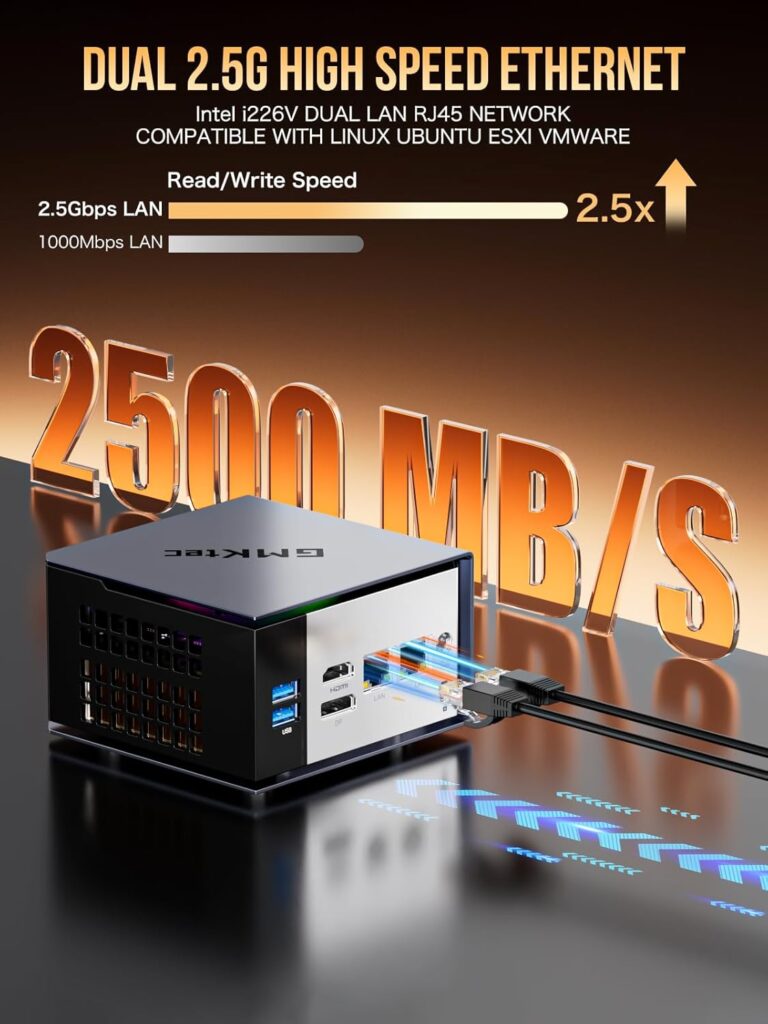
When compared to other high-performance mini PCs, the GMKtec EVO-X1 establishes itself as a top-tier contender in several key aspects. The AMD Ryzen AI 9 HX 370 processor with Zen 5 architecture outperforms many competing mini PCs based on older AMD or Intel platforms. The Radeon 890M iGPU likewise delivers graphics performance that exceeds what’s available in most competing products.
Connectivity is another area where the EVO-X1 shines compared to alternatives. While many mini PCs offer basic display outputs and USB ports, few provide the combination of dual 2.5Gbps LAN ports, triple 8K display support, and an OcuLink port for external GPU expansion. This level of connectivity makes the EVO-X1 more versatile for various use cases from home entertainment to professional workstations.
Where some competitors might have an edge is in RAM upgradeability. The EVO-X1’s onboard LPDDR5X memory, while extremely fast, can’t be upgraded after purchase. Some competing mini PCs with standard SODIMM slots allow for memory upgrades, though typically at lower speeds than the LPDDR5X offered in the EVO-X1. For most users, the performance advantages of the faster memory will outweigh the lack of upgradeability, especially if you choose a configuration with sufficient RAM from the start.
Is the GMKtec EVO-X1 Suitable for Content Creation and Professional Work?
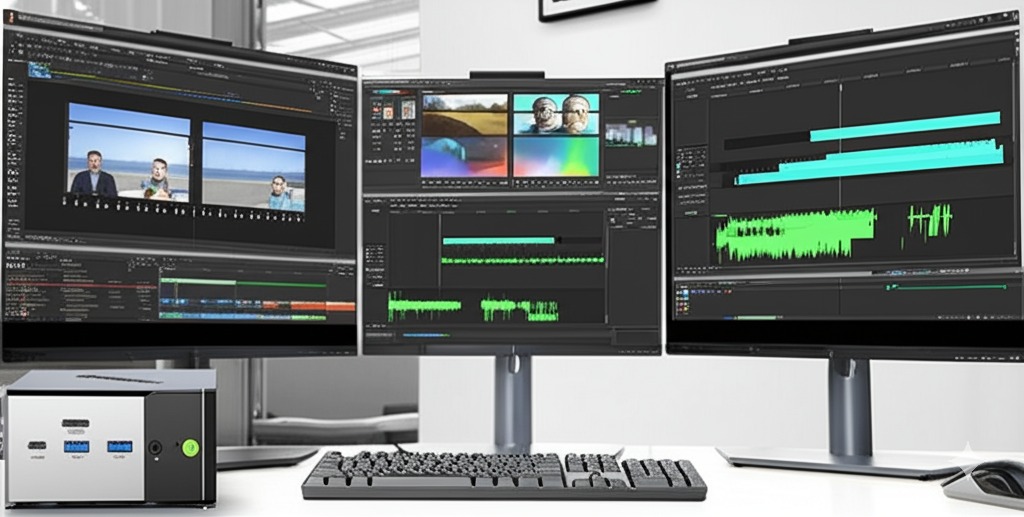
The GMKtec EVO-X1 is exceptionally well-suited for content creation and professional applications, thanks to its powerful CPU, capable graphics, and comprehensive connectivity options. The 12-core/24-thread Ryzen AI 9 HX 370 processor provides excellent multi-threaded performance for video editing, 3D rendering, compilation, and other professional workloads.
For creative professionals specifically, the combination of high processing power, fast memory, and the integrated Radeon 890M graphics makes the EVO-X1 capable of handling photo editing, video production, and graphic design tasks that would typically require a much larger system. The triple display support with up to 8K resolution is particularly valuable for creative workflows where screen real estate is at a premium.
The AI capabilities of the processor further enhance its suitability for next-generation creative applications. As more creative software incorporates AI features for tasks like smart selection, content-aware fills, and automated effects, having dedicated AI processing power becomes increasingly valuable. With up to 50 TOPS of AI performance, the EVO-X1 is well-positioned to handle current and future AI-enhanced creative applications more efficiently than systems without dedicated AI acceleration.
Here’s an introductory paragraph for your mini PC comparison blog post:
How does the GMKTec EVO-X1 Mini PC Compare to other AI Mini PCs?
The mini PC market has seen remarkable advances in 2025, with manufacturers packing impressive desktop-level performance into increasingly compact form factors. The AMD Ryzen AI 9 HX 370 processor has become a game-changer in this space, bringing powerhouse computing capabilities and AI acceleration to mini PCs. Three standout models have emerged as leaders in this category: the GMKTec EVO-X1, Beelink SER9, and GEEKOM IT1 Mega. While the first two leverage AMD’s powerful Ryzen AI 9 HX 370 with its integrated Radeon 890M graphics, GEEKOM takes a different approach with Intel’s latest Ultra processors. This comparison breaks down the key differences between these compact powerhouses to help you determine which mini PC best suits your specific needs, whether you’re a content creator, gamer, or professional looking for a space-saving desktop replacement.
- 【AMD Al Mini PC】Beelink SER9 Mini PC, AMD Ryzen 9 HX370(12C/24T, up to 5.1GHz), latest Zen5 Architecture, upgraded CPU+GPU+NPU AI Total Performance 80TOPS boosts mini computer overall performance,...
- 【Al Mini PC Boosts Work Efficiency】Beelink Ryzen 9 PC , AMD Radeon 890M 2900MHz iGPU accelerate Al drawing, resulting in faster image generation and more intricate details.12 cores and 24 threads...
- 【32G LPDDR5X +1TB PCIe4.0 SSD】Beelink AI Mini PC comes with 32GB(8GBx4) LPDDR5X 7500MHz High Frequency Memory, can deliver you the smoothest experience in Al computing, gaming and multimedia...
Processor & Performance
- GMKTec EVO-X1: Powered by AMD Ryzen AI 9 HX 370 (12 cores, 24 threads) reaching speeds up to 5.1GHz, with Radeon 890M integrated graphics featuring RDNA 3.5 architecture and configurable TDP up to 65W.
- Beelink SER9: Features the same AMD Ryzen AI 9 HX 370 processor with 12 cores, 24 threads, and Radeon 890M integrated graphics. Offers similar benchmark performance with options for balanced (54W) or performance (65W) modes.
- GEEKOM IT1 Mega: Takes a different approach with Intel processors. The high-end model features Intel Core Ultra 9 185H with 16 cores, 22 threads, turbo up to 5.1GHz and Intel ARC graphics rather than AMD hardware.
Memory & Storage
- GMKTec EVO-X1: Comes with 32GB LPDDR5X RAM running at 7500MHz (not user-upgradeable) and 1TB PCIe 4.0 SSD, with a 64GB RAM option also available.
- Beelink SER9: Offers 32GB LPDDR5X-7500 memory and 1TB PCIe Gen 4.0 SSD. Similar to the EVO-X1, the RAM is soldered and not user-upgradeable.
- GEEKOM IT1 Mega: Provides 32GB DDR5 RAM at 5600MHz with 2TB PCIe 4.0 SSD, with support for expansion up to 64GB.
Connectivity & Ports
- GMKTec EVO-X1: Features HDMI 2.1, DisplayPort 2.1, USB-C video output, dual 2.5G Ethernet ports, WiFi 6, Bluetooth 5.2, and multiple USB ports. The standout feature is the OCuLink port that allows connection to an external GPU.
- Beelink SER9: Includes HDMI, DisplayPort, USB-C, dual USB 3.2 ports (10Gbps), USB 2.0 ports, and a 2.5G LAN port. No OCuLink port for external GPU connection.
- GEEKOM IT1 Mega: Offers 2× USB4.0 ports (supporting DisplayPort 1.4), 2× HDMI 2.0 ports, dual 2.5Gbps Ethernet ports, and 5× USB 3.2 Gen2 ports. Features newer WiFi 7 and Bluetooth 5.4 connectivity.
Special Features
- GMKTec EVO-X1: The OCuLink port provides flexibility for expansion with external GPUs. Features a distinctive “floating style” design with customizable RGB lighting. Advanced cooling system with dual fans.
- Beelink SER9: Includes built-in speakers and microphone array with AI voice interaction capabilities. Features the MSC2.0 cooling system with vapor chamber technology.
- GEEKOM IT1 Mega: Features Intel AI Boost 1.4GHz NPU for AI acceleration, compatible with over 500 AI models. Includes IceBlast 2.0 cooling system for thermal management.
Size & Design
- GMKTec EVO-X1: Measures 7.32″ × 7.32″ × 5.28″ and weighs 3.87 pounds. Features aluminum alloy construction with RGB lighting.
- Beelink SER9: More compact at 135mm × 135mm × 44.7mm (5.31″ × 5.31″ × 1.76″) and weighing just 1.72 pounds, with a minimalist design available in frost silver or space gray finishes.
- GEEKOM IT1 Mega: Compact form factor measuring 5.4″ x 5.2″ x 2.1″ and weighing just 2.6 pounds with a premium metal chassis and clean design aesthetic.
Price Point
- GMKTec EVO-X1: Base model starts around $899, with 64GB configuration available for $1,029.
- Beelink SER9: Priced at $999 for the 32GB RAM/1TB SSD configuration.
- GEEKOM IT1 Mega: High-end model with Intel Core Ultra 9 and 2TB storage is priced competitively within this segment.
- 【14th Gen Intel Ultra 9 185H Processor】The GEEKOM IT1 Mega mini PC features the latest 14th Gen Intel Core Ultra 9 185H processor, with 16 cores, 22 threads, and a 24MB cache, turbo boosting up to...
- 【Intel ARC Graphics and Intel AI NPU】The GEEKOM IT1 Mega mini PC features Intel ARC graphics with DirectX 12 Ultimate for smooth 1080p AAA gaming. Powered by Intel XeSS technology, it enhances...
- 【Large Capacity and Compact Size】The GEEKOM minipc IT1 Mega comes with dual channel 32GB 5600 MT/s DDR5 RAM and a 2TB M.2 2280 NVMe Gen4*4 SSD, support extended up to 64GB(32GB+32GB) and 2TB SSD....
The GMKTec EVO-X1 distinguishes itself with the OCuLink port for external GPU support and specialized design for better cooling. The Beelink SER9 offers similar core performance with its identical processor but adds built-in speakers and microphones. GEEKOM’s IT1 Mega provides an Intel-based alternative with newer wireless connectivity standards.
For users wanting the option to add external GPU power later, the EVO-X1 offers the most flexibility. Those prioritizing an all-in-one solution with built-in audio might prefer the Beelink SER9. Intel loyalists or those wanting the very latest in wireless technology may find the GEEKOM IT1 Mega more appealing.
Should you buy the GMKTec EVO-X1 Mini PC?
The GMKtec EVO-X1 represents a significant advancement in mini PC capabilities, bringing desktop-class performance, AI processing, and gaming potential to a compact form factor. Whether you’re a content creator, professional, gamer, or just someone who values performance without sacrificing desk space, the EVO-X1 offers a compelling package that challenges conventional notions of what a mini PC can achieve.
- EVOLUTION AMD RYZEN 9 HX-370 MINI PC - GMKtec EVO-X1 is the next evolution in AI mini PC Ryzen AI 300 series, code named Strix Point. This processor brings out the highest TOPS from an NPU out, and it...
- AI NPU with XDNA 2 ARCHITECTURE - Equipped with an advanced AI NPU featuring the XDNA 2 architecture, EVO-X1 AI mini PC delivers up to 50 TOPS (Tera Operations Per Second) of AI processing power. This...
- AMD RADEON 890M iGPU GAMING PC - The latest RDNA 3.5 (Radeon 890M) in the Ryzen AI 9 HX 370 improves performance across all of our suites, which shows AMD has done wonders to improve their integrated...

I am a retired software engineer with experience in a multitude of areas including managing AWS and VMWare development environments. I bought a relative a mini-PC a year ago and have become passionate about the technology and its potential to change how we deploy software.

